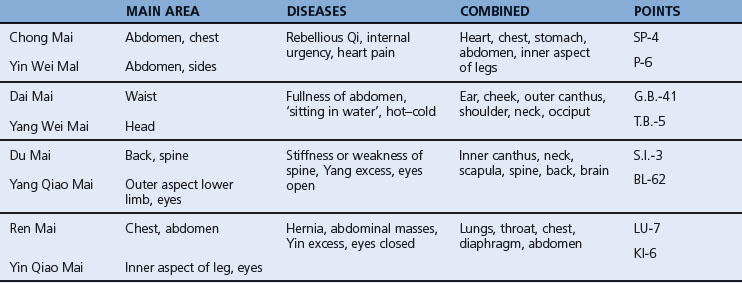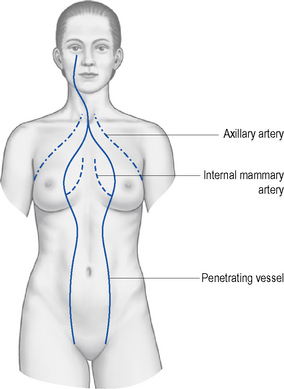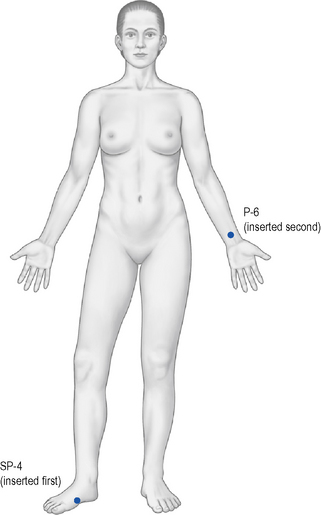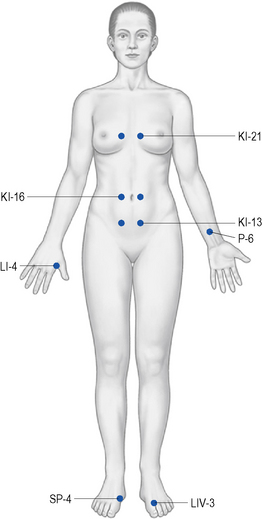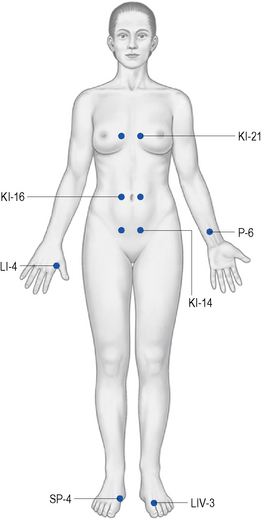CHAPTER 7 Treatment of the Extraordinary Vessels
Introduction
The eight Extraordinary Vessels and their opening points are:
Because of this arrangement in pairs, the opening point of one vessel is usually used in conjunction with the opening point of the paired vessel. This technique, called ‘host–guest’, was indicated for the very first time in the Guide to Acupuncture Channels (Zhen Jiu Jing Zhi Nan 1295) and later expanded in the Great Compendium of Acupuncture (Zhen Jiu Da Cheng 1601).2 For example, when using the Directing Vessel, one would needle LU-7 Lieque and KI-6 Zhaohai in this order, the former being its opening point and the latter its associated point (and opening point of its paired vessel, Yin Stepping Vessel).
There are two possible ways of proceeding:
Above–Below Bilaterally
Although this method of needling according to sex and laterality is not mentioned in the Great Compendium of Acupuncture, that book does suggest needling first the opening point of the chosen vessel and then that of its associated vessel (e.g. LU-7 Lieque and KI-6 Zhaohai for the Directing Vessel).3
When used in such pairs, the Extraordinary Vessels’ points also harmonize Above and Below as the paired points are always one from the arm and one from the leg. By using these points as pairs, one transcends the action of the individual points and brings into play the energy of the Extraordinary Vessels: it is as if one needed two keys to open a door. That is why I prefer to use the points of the Extraordinary Vessels in pairs. Some doctors in China studied whether the Extraordinary Vessels work better by using the opening point on its own or with its associated point: they report a case of a woman suffering from mental illness for whom they used S.I.-3 Houxi without good results; when this point was associated with BL-62 Shenmai, results improved.4
3 Problems of several channels simultaneously, complicated conditions, involvement of an internal organ with a different channel, confusing situations of Heat–Cold and deficiency–excess, some mental problems, some neurological problems, the pulse having the same quality in several positions
Confusing situations of Heat and Cold or of deficiency and excess
The pathology of the Penetrating Vessel is largely responsible for conditions characterized by confusing symptoms of Heat and Cold as explained in Chapter 3 on pathology. When the Qi of the Penetrating Vessel rebels upwards, it may cause a feeling of heat in the face and, because of a deficiency of Qi in the descending branch of this vessel, cold feet. The Penetrating Vessel is similarly involved in confusing situations of deficiency and excess: for example, a Kidney deficiency may not only cause the Penetrating Vessel to be Empty in the Lower Burner but also cause Qi to rebel upwards with symptoms of Fullness (stagnation of Qi) in the chest.
Some mental problems
The Extraordinary Vessels are often used for mental–emotional problems, especially the Governing Vessel, the Yang Stepping Vessel, the Penetrating Vessel and the Yin Linking Vessel, as explained in Chapter 3 on pathology.
Conditions in which the pulse acquires the same quality in different positions
This means that the pulse has exactly the same quality, for example, on both Front positions, or on both Guan positions, or on all positions of one side. The Study of the Eight Extraordinary Vessels by Li Shi Zhen describes in detail certain pulse qualities related to these vessels.5 The main pulse findings are detailed below:
The Extraordinary Vessels are also related to the Four Seas:
Penetrating vessel (chong mai)
The Penetrating Vessel also controls the breasts in several ways. The pathway of this vessel runs from the lower abdomen along the Kidney channel and then fans out over the breasts and chest on its way to the throat and eyes. The major arteries that feed the breast, i.e. the axillary artery supplying the outer half and the internal mammary arteries the inner half of the breast, are controlled by the Penetrating Vessel in two ways: because this vessel is the Sea of Blood and controls all blood vessels, and because this vessel spreads over the breasts in women. For this reason, the Penetrating Vessel exerts an important influence on pre-menstrual breast distension, breastfeeding and breast lumps. Because the Penetrating Vessel is the Sea of Blood and breast milk is a transformation of Blood, this vessel influences the supply of breast milk in two ways: if the Penetrating Vessel is Empty, the Sea of Blood is depleted and there may not be enough milk. If the Qi of the Penetrating Vessel is stagnant, the breast Connecting (Luo) channels will be blocked and the milk may not flow even though it is abundant. Figure 7.1 illustrates the pathway of the Penetrating Vessel in relation to the arteries feeding the breast.
To open the Penetrating Vessel in a woman, I needle SP-4 Gongsun first on the right followed by P-6 Neiguan on the opposite side: the needles are retained for about 20–25 minutes and withdrawn in the reverse order. Apart from obtaining the needling sensation (deqi), it is not necessary to perform any other needling manipulation. Since the subject is gynecology, I shall assume from now on that the opening point is inserted on the right side and the associated one on the left (Fig. 7.2).
As indicated in Chapter 3, rebellious Qi is a frequent pathology that affects the Penetrating Vessel. Indeed, the word chong in Chinese is also used as a verb to indicate the pathological rising of Qi towards the top. For example, when the Qi of the fetus rebels upwards and disturbs the mother, it is called tai qi chong yu shang, i.e. the “Qi of the fetus rebels (chong) upwards”. The main symptoms and signs indicating such a syndrome are abdominal pain and distension, a feeling of oppression of the chest and throat, palpitations, a suffocating sensation, a feeling of heat in the head, cold feet, anxiety and a pulse that is Firm on all three positions of the left side. Not all these symptoms need be present to use this vessel, but it is usually necessary to have three or four of these symptoms at different levels of the trunk to diagnose this syndrome.
The following is an example of point combinations to open the Penetrating Vessel for the Empty type of syndrome of rebellious Qi, i.e. one that derives from a Kidney deficiency: SP-4 Gongsun on the right (inserted first), P-6 Neiguan on the left (inserted second), L.I.-4 Hegu on the right, LIV-3 Taichong on the left, KI-13 Qixue, KI-16 Huangshu, KI-21 Youmen, the last three all bilateral (Fig. 7.3). In this combination, SP-4 and P-6 regulate Qi of the Penetrating Vessel; L.I.-4 and LIV-3 help to regulate the ascending and descending of Qi; KI-13 tonifies the Kidneys and the Penetrating Vessel; KI-16 harmonizes Kidneys and Heart and helps to subdue rebellious Qi; KI-21 helps to subdue rebellious Qi.
An example of point combination for the Full type of Rebellious Qi of the Penetrating Vessel is as follows: SP-4 on the right, followed by P-6 on the left, L.I.-4 Hegu on the right, LIV-3 Taichong on the left, KI-14 Siman, KI-16 Huangshu, KI-21 Youmen, the last three all bilateral (Fig. 7.4).
KI-11 Henggu (Horizontal Bone)
‘Horizontal Bone’ indicates the pubic bone, over which this point lies.
KI-12 Dahe (Great Flourishing)
The actions of KI-12 are as follows. It:
It can be combined with KI-2 Rangu for contraction of the genitals.
KI-13 Qixue (Qi Hole)
The actions of this point are as follows. It:
In Full conditions, KI-13 Qixue is used for rebellious Qi of the Penetrating Vessel causing an upsurge of energy from the lower abdomen to the chest and throat. It should be noted, however, that in such conditions it need not necessarily be reduced: if the condition of rebellious Qi is secondary to a Kidney deficiency and an Emptiness in the Lower Burner as described above, then this point should be tonified. The Great Dictionary of Chinese Acupuncture compares this point with the keys of a wind musical instrument. It says that it moves Blood through Qi (Qi being compared with the air in a wind instrument and the Kidney points on the abdomen presumably corresponding to its keys), and that it treats the running piglet surging upwards and the beng lou (Flooding and Trickling) leaking downwards.6
KI-14 Siman (Four Fullnesses)
The actions of KI-14 Siman are as follows. It:
KI-18 Shiguan (Stone Gate)
‘Stone’ here indicates fullness, hardness: this refers to the main indication for this point, i.e. fullness and hardness of the epigastrium. ‘Gate’ refers to the pyloric sphincter of the stomach through which the digested food passes on its way to the small intestine. The Great Dictionary of Acupuncture gives a different interpretation of this name, saying that shi can sometimes mean ‘water’: hence shi here would indicate the Water of the Kidneys, and the name would mean ‘Gate of the Kidneys’.7 Yet another interpretation given in the same dictionary is that ‘Stone Gate’ here refers to the blockage of stools (the point treats constipation) and to infertility, i.e. two stone gates are blocking the passage of stools and sperm.
The main actions of this point are as follows. It:
KI-21 Youmen (Dark Door)
The actions of KI-21 Youmen are as follows. It:
The indications of KI-21 Youmen in the gynecological sphere include palpitations, anxiety, poor memory, abdominal fullness and chest pain in women. The book Acupuncture reports the last symptom from an old classic: this is interesting as it confirms that this point treats the Penetrating Vessel in women in conditions of rebellious Qi.8
Penetrating Vessel: summary and case histories
A 45-year-old woman had been suffering from tiredness, blurred vision, palpitations, a panicky, anxious feeling in the chest with a feeling of energy rising, insomnia, headaches during the periods, pre-menstrual tension with abdominal distension, a feeling of heat in the face but cold hands and feet. Her tongue was Bluish-Purple and her pulse was Fine but also slightly Firm in all three positions of the right side (Plate 1).

